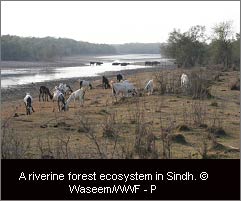The riverine forests in the province of Sindh occur along both banks of the Indus River. They rely on inundation by the River for irrigation and therefore their existence is heavily dependent on the intensity, duration and frequency of river water flow .
The newly deposited soils support the growth of species like Saccharum bengalense, Saccharum spontaneum, Tamarix dioica, Tamarix indica and Populus euphratica. As the land becomes stable vegetation comprises of species like Acacia nilotica, Prosopis cineraria and Cynodon dactylon. Under arid conditions vegetation is comprised of species like Prosopis cineraria,Salvadora persica, S. oleoides, Capparis decidua, Acacia senegal, A. jacquemontii,
Rivereine forests are the mainstay of forestry in Sindh. Besides providing a source of livelihood for thousands of people, these forests provide fuel wood, timber, fodder, honey and tannin. Moreover, they serve as carbon sinks and also protect the surrounding areas from the severity of floods .
 In recent times, only 50 percent of the gross area of riverine forests is inundated even in high floods. As a result, the riverine forest area is shrinking alarmingly while less salt tolerant species have almost disappeared. The existing condition is likely to further deteriorate with the construction of new dams and barrages, enabling only 20 percent of the original forest area to get inundated. In recent times, only 50 percent of the gross area of riverine forests is inundated even in high floods. As a result, the riverine forest area is shrinking alarmingly while less salt tolerant species have almost disappeared. The existing condition is likely to further deteriorate with the construction of new dams and barrages, enabling only 20 percent of the original forest area to get inundated.
|
